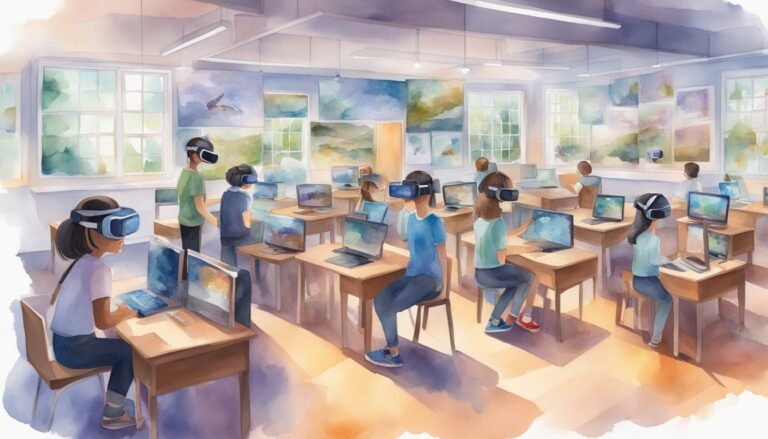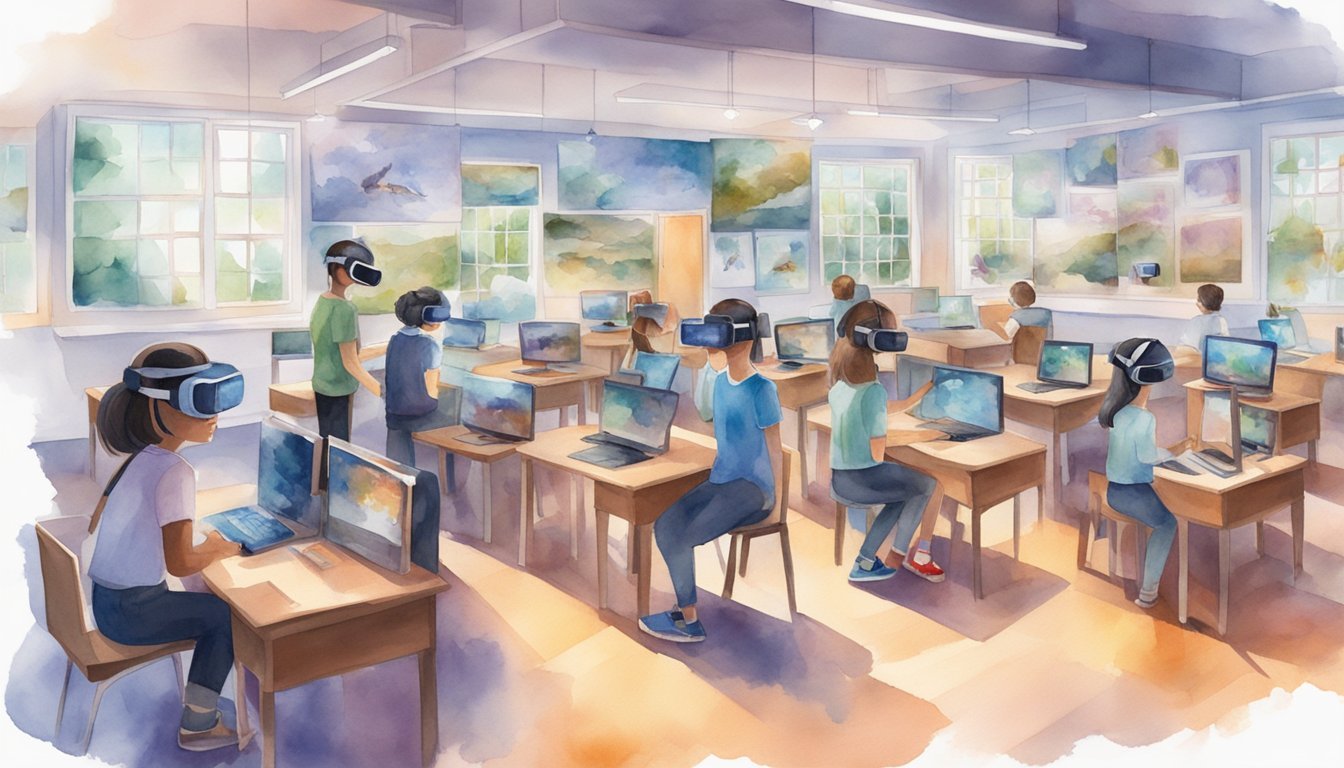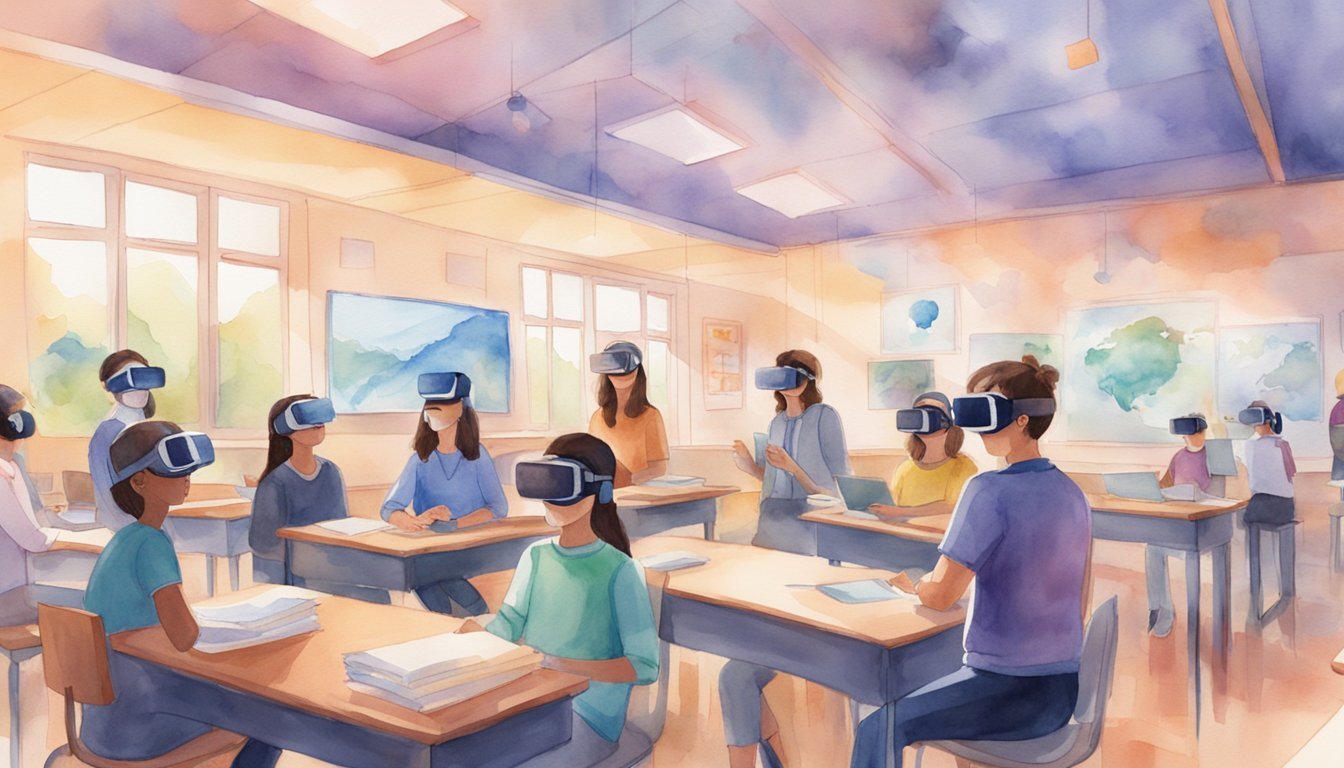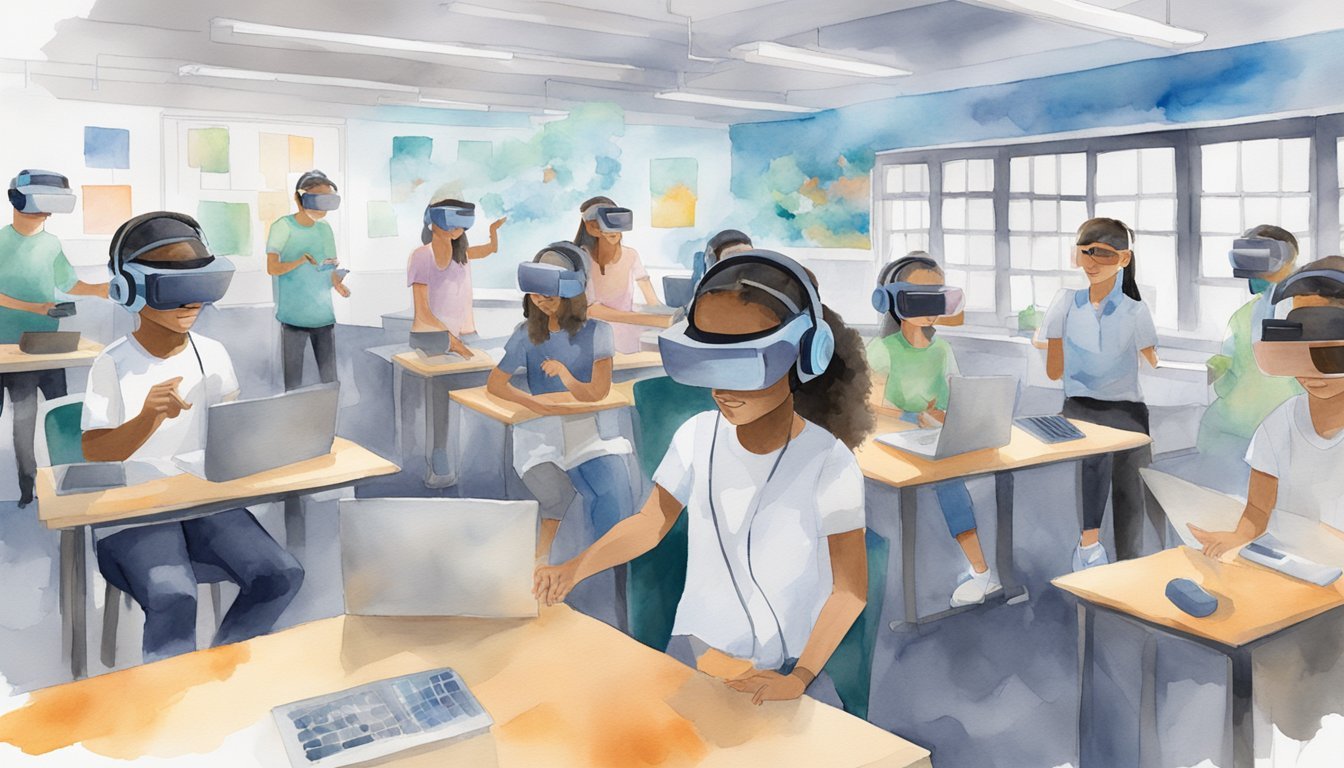7 Virtual Reality Educational Experiences for K-12: Transforming Classroom Learning

Virtual reality is changing how students learn.
This technology lets kids explore new places and ideas without leaving the classroom.
It makes lessons more fun and helps kids understand hard topics better.

Virtual reality can give students amazing chances to learn in K-12 schools. You can use it to take virtual field trips, see historical events, or do science experiments.
This article will show you 7 great ways to use virtual reality for learning.
These ideas can help make school more exciting for kids of all ages.
1) Tilt Brush

Tilt Brush is a virtual reality painting application that lets you create art in 3D space.
It’s a great tool for K-12 students to explore their creativity in a whole new way.
With Tilt Brush, you can paint using three-dimensional brush strokes.
You can add stars, light, and even fire to your creations.
This opens up a world of possibilities for artistic expression.
The app is easy to use and intuitive.
Students can quickly learn how to navigate the virtual space and start creating.
They can walk around their artwork and view it from different angles.
Tilt Brush is not just for art classes.
It can be used in other subjects too.
For example, students can create 3D models of historical events or scientific concepts.
Teachers can use Tilt Brush to make learning more engaging.
You can create virtual environments for your lessons or let students make their own to show what they’ve learned.
One of the best features of Tilt Brush is its ability to let users add their own images, 3D objects, and videos.
This means you can bring real-world elements into your virtual creations.
Tilt Brush can help improve spatial awareness and creativity.
It gives students a new way to express their ideas and understand complex concepts.
Remember, using VR in education should be done in moderation.
Make sure to follow safety guidelines and limit session times to prevent eye strain or dizziness.
2) Google Expeditions
Google Expeditions is a virtual reality teaching tool that brings exciting field trips to your classroom.
You can choose from over 100 virtual trips to amazing places around the world and beyond.
With Google Expeditions, you can take your students to Mars, the Great Barrier Reef, or the Great Wall of China without leaving school.
The app works with Google Cardboard, making it easy and affordable to use.
Teachers can lead the class on these virtual journeys.
You simply download the app onto devices that fit into Google Cardboard viewers.
Then you’re ready to guide your students through incredible virtual experiences.
The Google Expeditions AR Pioneer Program adds augmented reality to the mix.
This lets you place 3D objects in your classroom for students to explore.
They can walk around these objects, get up close to see details, and step back for a full view.
You can use these virtual field trips to launch a project, introduce a new topic, or bring a lesson to life.
The immersive nature of VR helps capture students’ attention and makes learning more engaging.
Google Expeditions is free to use.
Some schools can even get free equipment through Google’s Pioneer Programme.
This program brings all the needed gear to your school, including access to over 400 Expeditions.
3) CoSpaces Edu
CoSpaces Edu is a user-friendly platform that lets students create their own 3D worlds, animations, and games.
You can use it to bring lessons to life in virtual and augmented reality.
With CoSpaces, you can design interactive spaces using simple drag-and-drop tools.
No coding experience is needed to get started.
Students can add 3D objects, characters, and environments to build their projects.
For more advanced users, CoSpaces offers coding options.
You can animate creations with code to make them truly interactive.
This helps develop valuable STEM skills while working on engaging projects.
Teachers can use CoSpaces to create virtual field trips or historical reenactments.
Students can build models of scientific concepts or design storytelling environments.
The possibilities are vast across many subjects.
One of the best features is the ability to view projects in VR or AR.
You can explore creations using VR headsets or view them through mobile devices.
This brings student work to life in immersive ways.
CoSpaces puts a focus on student privacy and safety.
The platform is designed to be kid-friendly and complies with important privacy laws for educational technology.
By using CoSpaces, you can modernize your curriculum and make it more engaging.
It works well as a complement to traditional teaching methods or as a way to create entirely new learning experiences.
4) Labster VR

Labster VR offers exciting virtual lab experiences for K-12 students.
You can explore immersive STEM learning simulations that engage students and improve learning outcomes.
With Labster VR, you get to perform virtual experiments in a safe environment.
The platform provides realistic lab settings where you can practice techniques without the risks of a physical lab.
You’ll find a wide range of science topics covered in Labster’s simulations.
From biology to chemistry and physics, there’s something for every curious young scientist.
The virtual labs give you a taste of real-world scientific challenges.
You can experience the thrill of solving problems just like professional scientists do.
Teachers can use Labster VR to supplement classroom learning.
The virtual reality simulations help reinforce concepts taught in class and allow for hands-on practice.
Labster is designed to work well for high school students.
But with some guidance from teachers, younger students can also benefit from these virtual labs.
The company is working to build evidence that their VR simulations meet educational standards.
They’ve engaged researchers to study how Labster impacts K-12 science learning.
By using Labster VR, you get to explore exciting STEM careers.
The simulations let you step into the shoes of scientists and see what their work is really like.
5) Nearpod VR Lessons
Nearpod VR offers exciting virtual reality field trips for K-12 students.
You can use these lessons to bring the world into your classroom without leaving your school.
With Nearpod VR, you get access to 450 ready-to-run VR lessons.
These cover a wide range of subjects and grade levels.
You don’t need special VR headsets to use them.
Students can explore these virtual worlds using iPads, laptops, or Chromebooks.
This makes it easy to bring VR into any classroom setting.
The lessons are designed to be both fun and educational.
For example, you can take your students on a virtual trip to the Eiffel Tower to learn about shapes in 3D objects.
Nearpod VR aims to boost student engagement.
The lessons are built with sound teaching methods in mind.
This ensures that the VR activities fit well into your overall lesson plans.
You can even create your own VR experiences using Nearpod.
This lets you tailor the virtual trips to your specific teaching goals.
By using Nearpod VR, you can give your students real-world experiences without leaving the classroom.
This can help broaden their horizons and spark their interest in learning.
6) Unimersiv
Unimersiv offers virtual reality educational experiences for students of all ages.
You can explore various topics through immersive 3D environments.
With Unimersiv, you can take your class on virtual field trips to places that would be impossible to visit in real life.
These include journeys inside the human body and trips to outer space.
The platform aims to make learning fun and engaging.
You can download the Unimersiv app to access multiple educational experiences on history, space, and anatomy.
For teachers, Unimersiv provides a way to bring VR into your classroom.
This technology allows you to take your students on immersive virtual journeys.
Unimersiv focuses on two main areas: professional VR training and consumer/school market.
They create powerful VR experiences to help users learn more effectively.
By using Unimersiv, you can give your students experiences that go beyond traditional books or videos.
This approach can help make complex subjects more understandable and memorable.
The platform is designed to work with various VR headsets, making it accessible for schools with different technology setups.
You can contact Unimersiv directly to learn more about using their VR experiences in your classroom.
7) zSpace
zSpace offers AR/VR learning experiences for K-12 students.
This technology brings new ways to learn in classrooms, at home, or in hybrid settings.
With zSpace, you can explore subjects that were hard to teach before.
It works well for STEM topics and helps students make real-world connections.
The system supports group work too.
Students can team up and learn together using virtual reality.
This makes lessons more fun and helps kids work as a team.
zSpace is good for all kinds of learners.
It can help students who need extra support.
The hands-on nature of VR makes it easier for some kids to understand tough ideas.
Teachers like that zSpace lets them ask deeper questions.
Students often think more about what they’re learning when they use VR.
Many schools now use zSpace.
In fact, over 400 U.S. school districts have added it to their classrooms.
This means lots of students get to try this cool tech.
zSpace can make hard topics easier to grasp.
It brings lessons to life in a way books can’t. This helps you remember what you learn and makes school more exciting.
The Benefits of Virtual Reality in Education
Virtual reality brings unique advantages to K-12 classrooms.
It boosts student engagement, enables hands-on interactive learning, and provides access to immersive environments otherwise impossible to experience.
Enhanced Engagement
VR captures students’ attention in ways traditional methods can’t match. Immersive learning experiences spark curiosity and motivation.
You’ll find students more eager to participate and explore topics deeply.
VR lessons feel like adventures, not chores.
This increased engagement leads to better focus and knowledge retention.
Students remember VR experiences vividly, helping concepts stick.
Key engagement benefits include:
• Increased participation
• Higher motivation levels
• Improved focus and attention
• Better retention of information
Interactive Learning
VR allows students to interact with subject matter directly.
You can manipulate 3D models, conduct virtual experiments, and practice skills in safe simulations.
This hands-on approach suits various learning styles.
Visual and kinesthetic learners especially benefit. VR in education often involves using headsets and controllers to navigate virtual worlds.
Interactive VR activities include:
• Dissecting virtual organisms
• Building historical structures
• Practicing public speaking
• Conducting chemistry experiments
These interactive experiences reinforce learning through doing, not just observing.
Access to Immersive Environments
VR transports students to places and times otherwise inaccessible.
You can explore ancient civilizations, dive into ocean depths, or walk on distant planets.
These immersive field trips expand horizons beyond classroom walls.
Students gain context for abstract concepts by experiencing them firsthand.
VR applications have gained popularity in education due to their impact on enjoyment and memory retention.
Immersive environments make learning more vivid and memorable.
Examples of VR field trips:
• Ancient Rome tour
• Great Barrier Reef dive
• Mars surface exploration
• Inside a human cell
These virtual journeys inspire curiosity and deepen understanding across subjects.
Making Virtual Reality Accessible for K-12
Virtual reality can transform learning for K-12 students.
There are ways to make this technology more accessible in schools through affordable options, proper teacher preparation, and smart integration into lessons.
Cost-Effective Solutions
You don’t need expensive equipment to bring VR to your classroom. Affordable VR headsets like Google Cardboard work with students’ smartphones.
Many free VR apps offer educational content.
Some schools use shared VR carts that move between classrooms.
This lets more students access the technology without buying a headset for each child.
Grant programs and partnerships with tech companies can help fund VR initiatives.
Look into these options to offset costs.
Teacher Training
For VR to succeed in schools, teachers need proper training.
Professional development should cover:
- Basic VR operation
- Choosing appropriate content
- Managing a VR-equipped classroom
- Addressing technical issues
Hands-on practice is key.
Give teachers time to explore VR themselves before using it with students.
Create a support system where tech-savvy staff can help others.
This builds confidence in using the new tools.
Curriculum Integration
VR isn’t just for fun – it must tie into your curriculum goals. Review existing lesson plans to find natural spots to add VR experiences.
Use VR to:
- Take virtual field trips
- Visualize complex concepts
- Practice skills in a safe environment
Start small with short VR activities.
Gradually increase use as you and your students get comfortable.
Always have a backup plan in case of technical issues.
VR should enhance, not replace, traditional teaching methods.
Frequently Asked Questions
Virtual reality offers exciting new ways for K-12 students to learn.
It can take them on virtual field trips, let them explore 3D models, and make abstract concepts more concrete.
What are the most effective VR applications currently being used in K-12 education?
Google Expeditions is one of the most popular VR apps for K-12.
It lets students go on virtual field trips to places like ancient ruins or outer space.
Tilt Brush lets kids create 3D art in a virtual space.
This can help with spatial reasoning and creativity.
CoSpaces Edu allows students to build their own 3D worlds and stories.
It’s great for projects in many subjects.
How does virtual reality enhance the learning experience for students in primary and secondary education?
VR makes learning more engaging and interactive.
Instead of just reading about the pyramids, you can walk around a virtual version.
It helps with visualization.
Complex science concepts become easier to understand when you can see and interact with 3D models.
VR also allows for safe practice of skills.
Students can do virtual lab experiments or practice public speaking in a low-pressure setting.
In what ways has virtual reality technology impacted student engagement and retention in the classroom?
VR can make lessons more exciting.
When you’re fully immersed in a topic, it’s easier to stay focused and interested.
It can improve memory.
The vivid experiences in VR often stick in students’ minds better than traditional lessons.
VR also caters to different learning styles.
Visual and kinesthetic learners especially benefit from the hands-on nature of VR.
What are the essential components necessary to create an immersive VR educational experience?
High-quality visuals are crucial.
The more realistic the virtual environment, the more immersive it feels.
Interactivity is key.
Students should be able to manipulate objects and explore freely in the virtual space.
Clear learning objectives are important.
The VR experience should tie directly to the lesson goals.
How are educational institutions integrating VR into their existing curricula?
Many schools use VR as a supplement to regular lessons.
For example, a history class might use a VR field trip to ancient Rome.
Some teachers use VR for project-based learning.
Students might create their own VR worlds to demonstrate understanding of a topic.
VR is also being used for special needs education.
It can provide safe spaces for students to practice social skills or life tasks.
What are the pros and cons of using virtual reality as an educational tool in K-12 schools?
Pros include increased engagement, better visualization of complex concepts, and the ability to experience things not possible in real life.
VR can also help with empathy.
Students can see the world from different perspectives.
Cons include the cost of equipment and the need for teacher training.
Some students may also experience motion sickness.
There’s also a risk of overuse.
VR should enhance, not replace, traditional teaching methods.

